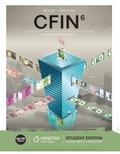
EBK CFIN
6th Edition
ISBN: 9781337671743
Author: BESLEY
Publisher: CENGAGE LEARNING - CONSIGNMENT
expand_more
expand_more
format_list_bulleted
Question
Chapter 4, Problem 10PROB
Summary Introduction
The annual payment is $450 for the last 14 years at 8% compounded annually.
Future value of an annuity due is the total future value of a series of periodic payments made at the beginning of each year at a given interest rate for a specified period.
Here,
The future value annuity is “
The periodic payments are “P”.
The interest rate is “r”.
The maturity period of time period is “n”.
Expert Solution & Answer
Want to see the full answer?
Check out a sample textbook solution
Students have asked these similar questions
Solve this problem please .
Solve this finance question.
Calculate dividend using appro
Chapter 4 Solutions
EBK CFIN
Ch. 4 - Prob. 1PROBCh. 4 - Prob. 2PROBCh. 4 - Prob. 3PROBCh. 4 - Prob. 4PROBCh. 4 - Prob. 5PROBCh. 4 - Prob. 6PROBCh. 4 - Prob. 7PROBCh. 4 - Prob. 8PROBCh. 4 - Prob. 9PROBCh. 4 - Prob. 10PROB
Ch. 4 - Prob. 11PROBCh. 4 - Prob. 12PROBCh. 4 - Prob. 13PROBCh. 4 - Prob. 14PROBCh. 4 - Prob. 15PROBCh. 4 - Prob. 16PROBCh. 4 - Prob. 17PROBCh. 4 - Prob. 18PROBCh. 4 - Prob. 19PROBCh. 4 - Prob. 20PROBCh. 4 - Prob. 21PROBCh. 4 - Prob. 22PROBCh. 4 - Prob. 23PROBCh. 4 - Prob. 24PROBCh. 4 - Prob. 25PROB
Knowledge Booster
Learn more about
Need a deep-dive on the concept behind this application? Look no further. Learn more about this topic, finance and related others by exploring similar questions and additional content below.Similar questions
- What is the finance ? tell about its significant.arrow_forwardTake value of 1.01^-36=0.699 . step by steparrow_forwardsolve this question.Pat and Chris have identical interest-bearing bank accounts that pay them $15 interest per year. Pat leaves the $15 in the account each year, while Chris takes the $15 home to a jar and never spends any of it. After five years, who has more money?arrow_forward
arrow_back_ios
SEE MORE QUESTIONS
arrow_forward_ios
Recommended textbooks for you

How To Calculate The Present Value of an Annuity; Author: The Organic Chemistry Tutor;https://www.youtube.com/watch?v=RU-osjAs6hE;License: Standard Youtube License